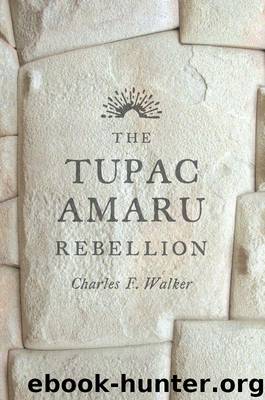The Tupac Amaru Rebellion by Walker Charles F

Author:Walker, Charles F. [Walker, Charles F.]
Language: eng
Format: epub
Publisher: Harvard University Press
Published: 2014-04-08T05:00:00+00:00
The Siege of La Paz
The city of La Paz emerged in the eighteenth century as a commercial center, an important stop in the economic circuits that stretched from Buenos Aires on the Atlantic to Lima on the Pacific, with the ever-important Potosí silver mine in the middle. This trans-Andean trade route actually consisted of multiple overlapping circuits, from the interoceanic to the more local production by indigenous people of foodstuffs for cities and towns.29 La Paz had a population of about 25,000 in the late eighteenth century, rivaling Cuzco for primacy among Andean cities. Its unique topography makes it ideal for sieges. Built into a bowl, actually a wide canyon that holds the Choqueyapu River, the city center is surrounded by steep hills that lead to plateaus that surpass thirteen thousand feet above sea level. Like many Spanish-American cities, it was surrounded by a large wall, with much of the indigenous population living on the outside or extramuros. In early 1780, royalist commanders had fortified the wall and added trenches. Today, the appropriately named town of “El Alto” or “the Tall One,” which stretches across the western plain above the city and constituted the traditional point of entry for people and goods, serves as the base for frequent strikes that paralyze the city below. In fact, the Neo-Kataristas who have led important and creative social movements in the last two decades take their name and heroes from the 1780s.30
On March 13, 1781, tens of thousands of Indian rebels led by Tupac Katari surrounded the city, impeding supplies from entering or people from leaving, unless they joined the insurgents. After a few weeks, shortages struck even in this well-stocked city. Katari sent representatives to negotiate, requesting that the towns’ people hand over their weapons as well as corregidors, Europeans, and some authorities. The city leaders refused. The indigenous population that lived outside the city’s walls largely joined the rebels. While the siege literally divided the population into royalists on the inside and rebels on the outside, relations between the two sides fluctuated between accommodation and implacable hatred. One diary hints that rebels allowed people they knew to get food, while sentries even greeted acquaintances over the wall. Other entries, however, refer to the rebels as bloodthirsty Indians. And relations worsened as time passed and hunger loomed.31
The two sides battled in April and May but to a bloody stalemate. Royalists could not break the rebel lines, even when they charged and killed hundreds with their artillery, while the insurgents could not take the city center. Rebels entered periodically, destroying parts of the city’s wall and burning sections of the city. They crept to the city’s walls in the dark of night to take prisoners or attack sentinels. Royalists used their firepower to ward off these nocturnal attacks. Tupac Katari himself ventured to the city’s walls several times.
Within a few weeks, the confrontation turned into a siege—the rebels focused on blocking supplies. Hunger spread and by the second half of April, the city’s residents had turned to cats, dogs, mules, and even leather for their meals.
Download
This site does not store any files on its server. We only index and link to content provided by other sites. Please contact the content providers to delete copyright contents if any and email us, we'll remove relevant links or contents immediately.
| Native American | Popol Vuh |
| Rastafari Movement |
The Four Agreements by Don Miguel Ruiz(6630)
Breaking Free by Rachel Jeffs(4175)
The Hatha Yoga Pradipika (Translated) by Svatmarama(3229)
120 Days of Sodom by Marquis de Sade(3179)
Member of the Family by Dianne Lake(2302)
The Tao of Physics by Fritjof Capra(2229)
The Psychedelic Gospels: The Secret History of Hallucinogens in Christianity by Jerry B. Brown(2121)
The Road to Jonestown by Jeff Guinn(2019)
Going Clear: Scientology, Hollywood, and the Prison of Belief by Lawrence Wright(1937)
Going Clear by Lawrence Wright(1922)
Uriel's Machine by Christopher Knight(1862)
The Grand Grimoire: The Red Dragon by Author Unknown(1760)
The Gnostic Gospel of St. Thomas by Tau Malachi(1738)
Key to the Sacred Pattern: The Untold Story of Rennes-le-Chateau by Henry Lincoln(1594)
The Malloreon: Book 02 - King of the Murgos by David Eddings(1558)
Waco by David Thibodeau & Leon Whiteson & Aviva Layton(1530)
The New World Order Book by Nick Redfern(1525)
Animal Speak by Ted Andrews(1514)
The Secret of the Temple by John Michael Greer(1463)
